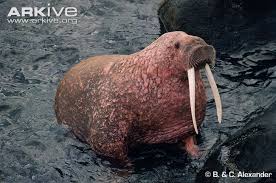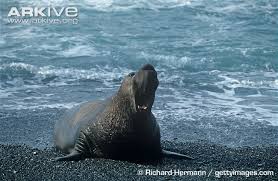Post by dinosauria101 on Apr 26, 2019 3:15:09 GMT 5
Pacific Walrus - Odobenus rosmarus divergens
Walruses occupy a nearly circumpolar region of the Arctic. Three distinct subspecific populations are recognized: 1) Atlantic (Odobenus rosmarus rosmarus), which lives in the eastern Canadian Arctic and Greenland east to Novaya Zemlya; 2) Pacific (O. r. divergens), living in the Bering Sea and adjacent Arctic Ocean; 3) Laptev Sea (O. r. laptevi), occupying the Laptev Sea, north of Siberia. Some taxonomists do not recognize the Laptev Sea population as a separate subspecies. Walruses prefer to inhabit areas with ice floes in the shallower regions near the coasts of Arctic waterways. Their seasonal migration patterns coincide with the changes in the ice. In the winter, walruses move south as the Arctic ice expands, and in the summer they retreat north as the ice recedes. This migration can cover distances of 3000 km. Individuals concentrate where the ice is relatively thin and dispersed in the winter. In the summer time, bulls may use isolated coastal beaches and rocky islets. Cows and young prefer to stay on ice floes in all seasons. While some outsized Pacific males can weigh as much as 2,000 kg (4,400 lb), most weigh between 800 and 1,680 kg (1,800 and 3,700 lb). The Atlantic subspecies weighs about 10–20% less than the Pacific subspecies. The Atlantic Walrus also tends to have relatively shorter tusks and somewhat more flattened snout. Females weigh about two-thirds as much, with the Atlantic females averaging 560 kg (1,200 lb), sometimes weighing as little as 400 kg (880 lbs), and the Pacific female averaging 794 kg (1,750 lb). Length ranges from 2.2 to 3.6 m (7.2–12 ft). It is the second largest pinniped, after the elephant seals.

Northern Elephant Seal - Mirounga angustirostris
The northern elephant seal (Mirounga angustirostris) is one of two species of elephant seal (the other is the southern elephant seal). It is a member of the family Phocidae ("true seals"). Elephant seals derive their name from their great size and from the male's large proboscis, which is used in making extraordinarily loud roaring noises, especially during the mating competition. Sexual dimorphism in size is great: The much larger male northern elephant seal typically weighs 1,500–2,300 kg (3,300–5,100 lbs) and measures 4–5 m (13.2–16.5 ft), although some males can weigh up to 3,700 kg (8,152 lbs). Females can range from 400 to 900 kg (990-2,000 lbs) and measure from 2.5 to 3.6 m (8.2–11.9 ft).

Credit to Wikipedia
NOTE 1: This may not seem sympatric, but their ranges have some overlap in the Bering Sea and southwestern Alaska
NOTE 2: I know the elephant seal's much bigger, but it would need the weight advantage due to the far better weapons of the walrus
Walruses occupy a nearly circumpolar region of the Arctic. Three distinct subspecific populations are recognized: 1) Atlantic (Odobenus rosmarus rosmarus), which lives in the eastern Canadian Arctic and Greenland east to Novaya Zemlya; 2) Pacific (O. r. divergens), living in the Bering Sea and adjacent Arctic Ocean; 3) Laptev Sea (O. r. laptevi), occupying the Laptev Sea, north of Siberia. Some taxonomists do not recognize the Laptev Sea population as a separate subspecies. Walruses prefer to inhabit areas with ice floes in the shallower regions near the coasts of Arctic waterways. Their seasonal migration patterns coincide with the changes in the ice. In the winter, walruses move south as the Arctic ice expands, and in the summer they retreat north as the ice recedes. This migration can cover distances of 3000 km. Individuals concentrate where the ice is relatively thin and dispersed in the winter. In the summer time, bulls may use isolated coastal beaches and rocky islets. Cows and young prefer to stay on ice floes in all seasons. While some outsized Pacific males can weigh as much as 2,000 kg (4,400 lb), most weigh between 800 and 1,680 kg (1,800 and 3,700 lb). The Atlantic subspecies weighs about 10–20% less than the Pacific subspecies. The Atlantic Walrus also tends to have relatively shorter tusks and somewhat more flattened snout. Females weigh about two-thirds as much, with the Atlantic females averaging 560 kg (1,200 lb), sometimes weighing as little as 400 kg (880 lbs), and the Pacific female averaging 794 kg (1,750 lb). Length ranges from 2.2 to 3.6 m (7.2–12 ft). It is the second largest pinniped, after the elephant seals.
Northern Elephant Seal - Mirounga angustirostris
The northern elephant seal (Mirounga angustirostris) is one of two species of elephant seal (the other is the southern elephant seal). It is a member of the family Phocidae ("true seals"). Elephant seals derive their name from their great size and from the male's large proboscis, which is used in making extraordinarily loud roaring noises, especially during the mating competition. Sexual dimorphism in size is great: The much larger male northern elephant seal typically weighs 1,500–2,300 kg (3,300–5,100 lbs) and measures 4–5 m (13.2–16.5 ft), although some males can weigh up to 3,700 kg (8,152 lbs). Females can range from 400 to 900 kg (990-2,000 lbs) and measure from 2.5 to 3.6 m (8.2–11.9 ft).
Credit to Wikipedia
NOTE 1: This may not seem sympatric, but their ranges have some overlap in the Bering Sea and southwestern Alaska
NOTE 2: I know the elephant seal's much bigger, but it would need the weight advantage due to the far better weapons of the walrus




